It always takes me a while to get my bearings when I arrive at Express Bus Terminal Station, whether I’m there to catch a ride out of town or on my way to somewhere in the neighborhood. Three lines merge here, one bus terminal is two terminals, there’s a department store, two shopping malls, maybe more, and jammed in between all that are shoe shops, makeup boutiques, salons, and even a sauna. I could live here. A couple times I’ve been so turned around that I thought I might have to.
Probably just about everyone in Seoul has been to this station before, check that, probably a solid majority of Koreans, full stop, have been here, as the Express Bus Terminal (고속터미널) is the biggest bus terminal in the country, linking the capital to pretty much everywhere on the mainland. The terminal is divided into two separate buildings, with the original building, where the Gyeongbu and Yeongdong Lines (경부선, 영동선) depart from, sitting on the plaza where Exit 1 drops you off. It’s also accessible directly from the station, though I’ve always had trouble doing things that way.
Inside the old terminal was a smattering of people buying tickets, lineups at the ATMs, some travelers wheeling luggage or shouldering bags, others using the coin-operated internet stalls, sailors and soldiers on break, plenty of folks getting quick pre-trip meals or buying snacks, and the less-comfortably dressed on their way to the fifth floor wedding hall. A few regional tourism signs were up, including one for the east coast province that read ‘Gangwondo, always on my mind.’ Buses were headed to Cheongju, Daejeon, and as far as Busan.
The old terminal is by no means dingy, but looking at it and the newer building across the way back-to-back shows the different Seouls they were built in. In the old terminal the upper floors are arranged like an indoor market, with floors dedicated to curtains and drapes, flower shops, bedding, and clothing. Conversely, the new terminal, serving the Honam Line (호남선), is attached to a Shinsegae department store and incorporated into the Central City complex.
From Exit 8 I walked across the plaza, past the Queen’s Guards and Swiss Guard statues posted on either side of the Shinsegae entrance, to the Central City/new terminal front doors. There’s something a bit odd about the lighting inside the station, and even in the middle of a good day it feels dim inside. Like the original terminal there are plenty of small places to eat, but more of them are chain restaurants, and things generally feel slightly less bus terminal-y, as there are as many shoppers here as there are travelers. Coaches bound for Gwangju or Haenam waited in their slots outside the terminal’s Lego-like red gates, but there were as many shopping bags as there were suitcases, and I spotted two guys with matching nose braces and masks, apparently just having gotten nose jobs together. To the left of the terminal entrance were the doors to Shinsegae and access to the attached Marriott Hotel, while downstairs was Young Plaza with the usual Megabox, Uniqlo, Bandi & Luni’s lineup.
A while back we were just down the street, at Banpo Station, and crossed through the space beneath the Sinbanpo-ro (신반포로) – Jamwon-ro (잠원로) intersection, marked as Gangnam Underground Shopping Center (강남지하상가) on the local map, hoping to find something, anything that might be going on in that ‘hood. At the time though, it was just an empty space, plywood and dim concrete halls. Now it’s part of the bright, lively GoTo Mall, which stretches under the bus terminal all the way to the Sinbanpo-ro – Banpo-ro (반포로) intersection a couple of long Gangnam blocks to the west. At that end, closest to Exit 8 or 8-1, was a collection of snack shops, boutiques, a bubble tea joint, and a cylindrical aquarium where a number of fish did fish things. The other end, nearest Exit 1 or 8-2, was a small food court, a fountain pool, and several flower shops that gave the mall a sweet aroma.
On the street above, the side of Sinbanpo-ro opposite the terminal is fronted by five-story buildings filled with shops, real estate offices, and hagwons. A disproportionate amount of the retail space is taken up by a variety of Christian shops. There were religious bookstores, places selling wooden crosses and Christian CDs, a shop called the Korea Protestant Department Store, and one store with choir robes displayed in its window.
The blocks between these stores and the river are occupied by apartment complexes, but bypassing these it’s a quick walk to the Han River Park (한강공원) by turning right down Banpo-ro from Exit 8-1. Newer buildings to the right, older ones in paint-flaking domino rows to the left, the sidewalk leading north is dotted with tiles pointing the way to the park and showing images of historical sites in the area. As you near the point where the Banpo Bridge begins you can either continue along the sidewalk to a set of stairs that leads down to the park, or you can cross to the middle of the road and take the ramp that does the same, the latter route leading past graffiti of laughing kids, a smooching fish and whale, and portraits of what looked like Chinese deities.
The park was predictably empty in mid-February, the grass still two-thirds covered in snow, though a handful of expats were out playing football, two bikers were taking a break under a canopied rest area, a man on a thick-wheeled unicycle rolled by, and a woman walked a pair of bichon fries that were both spotless white from their haunches up and coated a muddy brown below that. In warm months, however, this is one of the most popular stretches of the park, in part because of the Banpo Bridge Moonlight Rainbow Fountain (달빛무지개 분수), which is recognized by Guinness as the world’s longest bridge fountain, though just how deep that field is is not something I’ve ever heard the Korea Tourism Organization mention in the same breath. Competition (or lack thereof) aside, the fountain is pretty impressive, with nearly 400 nozzles and 200 lights and it’s certainly a nice backdrop to an evening picnic or date, though I’m personally of the opinion that if you’ve seen it once, well, you’ve seen it.
The stretch of the park below the bridge is called Moonlight Square (달빛광장) and from there you can see the gilt wedge of the 63 Building and the red and white spire of N Seoul Tower. In the river in front of the square are the Floating Islands (세빛둥둥섬), though the joke goes that they should really be called 세금둥둥섬, the Floating Tax Islands.
The Islands, a pet project of former mayor Oh Se-hoon (오세훈), are a trio of buildings on floating bases anchored to the river bottom, heralded as the first such constructions in the world. They were intended to function as meeting, convention, exhibition, entertainment, and recreational space, and were officially opened in June 2011 with a Fendi fashion show. Since then, however, they’ve done little but court controversy. Beset by construction and maintenance problems and unable to find a subcontractor to manage them, they’ve fallen into semi-neglect. The most recent twist in the tale came in mid-February when the Korean Bar Association requested an investigation be opened into Oh’s handling of the islands’ construction and contractual deals, as there are allegations of financial mismanagement. Oh, for his part, has blamed current mayor Park Won-soon (박원순) for not opening the islands to the public. And everyone is upset about what’s (not) happening with their tax dollars.
A pair of security guards was stationed in the booth at the entrance to the footbridge leading over the jade-colored river to the first island, but they had no problems with letting me walk out for a look around. I was the only one looking to do so. Sections of uncompleted or faulty walkway were attached to the side of the island and the first building was completely empty inside. I couldn’t see if the situation was the same with the other two buildings because the footbridges to them were blocked off, so instead I sat down in a funnel-shaped chair and just looked at the buildings and the river for a bit. They were pretty things, the islands, their aqueous curves graceful and well-harmonized with the river, and I hoped that they wouldn’t turn into a boondoggle. If they reached their potential they’d undoubtedly be a welcome addition to the city, but whether that would happen or not seemed rather uncertain at the moment.
The Express Bus Terminal is penned in by large roads, and the area immediately surrounding it is more suited to vehicles than pedestrians, but short walks southwest of the station from Exit 5 lead to areas that offer a bit of respite from the noise and fumes.
Just outside the exit are the headwaters of the Banpo Stream (반포천), a quiet little waterway that empties into the Han near Dongjak Bridge. Here there’s a walking path and some stepping stones that cross the stream. Across Sapyeong-dae-ro (사평대로) is Sorae Park (서래공원), which is less of a park than it is a spot for the area’s businessmen to take a break on one of the benches and grab a cigarette. Sculptures of horses gallop through a fountain pool, shaded by nearby trees.
If you pass the park and continue south along Banpo-ro, passing Catholic University (가톨릭대학교), you’ll eventually arrive at the National Library of Korea (국립중앙도서관). The first thing you’ll see is the black glass façade of the relatively new National Digital Library of Korea, or Dibrary, which opened in 2009. Inside, I was greeted by a little garden of digital screens displaying changing images of flowers. A section of the wall behind them had white on black Chinese and Hangeul characters in glass, which served as a stark contrast with all the high tech gadgetry around them. There were of course computers and laptop stations, but also kiosks where visitors could browse newspapers and a few magazines on touchscreens. Upstairs was a huge spread of computer stations, both desktop and laptop, along with meeting rooms; multiplexes where groups could watch videos; a Digital Editing Zone for video and image editing; and video and audio studios for producing and recording. I hadn’t been to a library in a long time, and the near-perfect silence was startling, especially in a tech-oriented space in a city as buzzing as Seoul.
The Dibrary elevator took me up to the first floor, which put me on a plaza in front of the main library. Large green letters across the top of the building read ‘국립중앙도사관 www.nl.go.kr’ and looking out from the middle of the ‘g’ as if to survey those entering its building was a lone magpie, which had built its nest there.
To enter interior of the library I had to register for a library card, which is available to any expat with an Alien Registration Card and is a piece of cake to get. Computers near the entrance let you register (in English) on the library’s website and after you do so the librarian on duty will give you a day pass for use that day. The next time you come back your card will be ready to pick up.
I wandered upstairs through the different sections of the library, which, all told, holds over 7.5 million items. Newspapers and government publications were on the third floor and material related to the sciences on the fourth. On the fifth floor was the maps and geography room, which was one of three areas I was looking forward to checking out. I can look at maps for hours, especially old ones, which, in the heroic endeavors that went into creating them and in their utter wrongness, strike me as both awe-inspiring and hilarious. Unfortunately, though, I had come on a Sunday, and the maps room isn’t open on weekends. Nor was one of the other areas I wanted to visit: the Information Center on North Korea (북한자료센터).
Thankfully, I was only 67% out of luck, because the Old and Rare collection on the sixth floor was open. In display cases by the door were an anthology of Zen teachings from 1377 and a Dharani sutra wood block print from 751. Inside, a half-dozen old men sat at tables flipping through even older books, and stacks of yellowed and worn books, most bound with string, lined rows of wood and glass cabinets. In the center of the room was a temporary display of materials from the Joseon era that included answers to exam questions and study manuals for those preparing for medical, military, and astronomical tests.
Just past the library you’ll notice the pedestrian Silkworm Bridge (누에다리) crossing high above Banpo-ro. Ten white rings provide the frame for white wiring, resulting in a structure that resembles the animal so closely associated with this part of Seoul. Climb up the steps leading up to the bridge and you’ll find yourself in Montmartre Park (몽마르뜨 공원), a pleasant hilltop park that offers unexpectedly fine views off to the southeast and southwest. Near the entrance was a spot that I believe is actually used as a reference point for GPS systems and making maps. Square stones around it signaled the directions of and distances to several cities around the world, including Washington D.C., Pyongyang, Singapore and Berlin. A number of people were walking their dogs around the path running along the hilltop, and four built or partially-built snowmen still dotted the field in its center.
Also near the Express Bus Terminal is the well-known Sorae Village (서래마을), or Sorae Maeul, which is a ten-minute walk from Exit 5. After walking west on Sapyeong-dae-ro turn left into Sorae-ro (서래로).
Sorae Village is also commonly known as the French Village thanks to the French influence that comes with the presence of the Lycée Français de Séoul at the end of Sorae-ro (the school crossing outside of which has its sign written in French, in addition to Korean and English). If you’re expecting a little slice of Paris when you show up, however, you might come away disappointed. I asked my girlfriend if the area felt French to her, and she responded by saying it felt more Japanese, which I kind of got. Japan certainly isn’t a four-week vacation, three-hour dinner kind of place like France is, but people are in less of a hurry there, more ready to savor things, and the little bit of Continental influence in the neighborhood seems able to tug Seoul about that far, if not any further.
To be sure, though, Sorae Maeul has a vibe unto itself, distinct from the rest of Seoul, and while it’s not French exactly, it seems like here, at least, people have some sort of understanding of la bon vie, of the pleasurable things in life and that sometimes what you should do is better not done in favor of what you would like to do. In some ways, the area’s reputation for charm is self-fulfilling: its reputation is that it’s a place to catch a whiff of Europe, so people come here to eat, drink, and get away from the more hectic parts of the city, which actually creates an atmosphere that’s more European and makes it a place to eat, drink, and get away from the more hectic parts of the city. No one comes here to conduct business. They come here to avoid conducting business, and to indulge in the preponderance of cafes, wine bars, and international restaurants.
As I strolled up and down the main street and along some of the back streets, a couple towheaded boys passed by babbling in French, shoppers wandered in and out of fashion and craft boutiques, people looked over the offerings at bakeries, and, perhaps most notably, nobody seemed in any particular rush to get anywhere. Sorae Maeul may not be a ticket to de Gaulle, but it’ll do.
Express Bus Terminal (고속터미널)
Old Terminal (Gyeongbu and Yeongdong Lines (경부선, 영동선))
Exit 1
New Terminal (Honam Line (호남선))
Exit 8
GoTo Mall
Exits 1, 8, 8-1, 8-2
Han River Park (한강공원), Banpo Bridge Moonlight Rainbow Fountain (달빛무지개 분수), and Floating Islands (세빛둥둥섬)
Exit 8-1
Right on Banpo-ro (반포로)
Banpo Stream (반포천)
Exit 5
Sorae Park (서래공원)
Exit 5
South on Banpo-ro (반포로)
National Library of Korea (국립중앙도서관) and National Digital Library of Korea (Dibrary)
Exit 5
South on Banpo-ro (반포로)
Phone | 02) 590-4142
National Library of Korea: www.nl.go.kr
National Digital Library of Korea: www.dibrary.net
Hours | Digital Library: Tuesday – Sunday 9:00-18:00, Closed Mondays
Silkworm Bridge (누에다리) and Montmartre Park (몽마르뜨 공원)
Exit 5
South on Banpo-ro (반포로)
Sorae Village (서래마을)
Exit 5
West on Sapyeong-dae-ro (사평대로), Left on Sorae-ro (서래로)





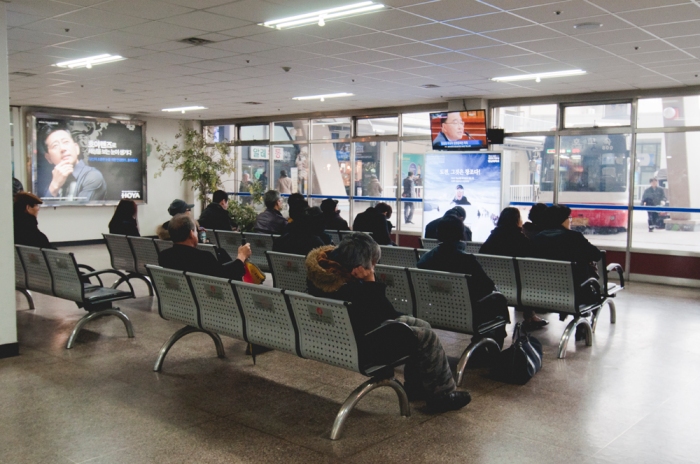




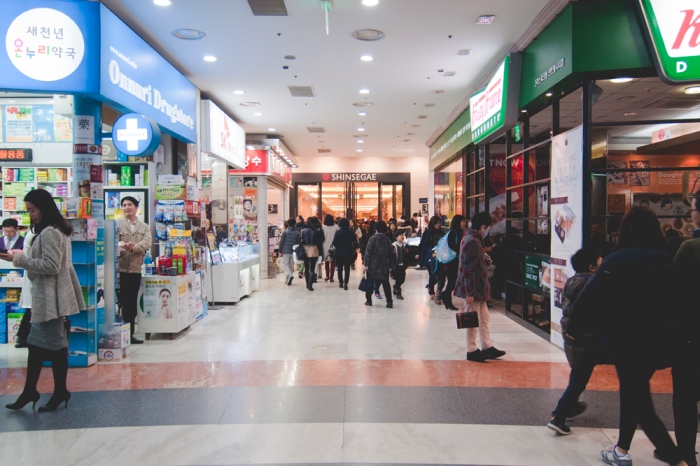






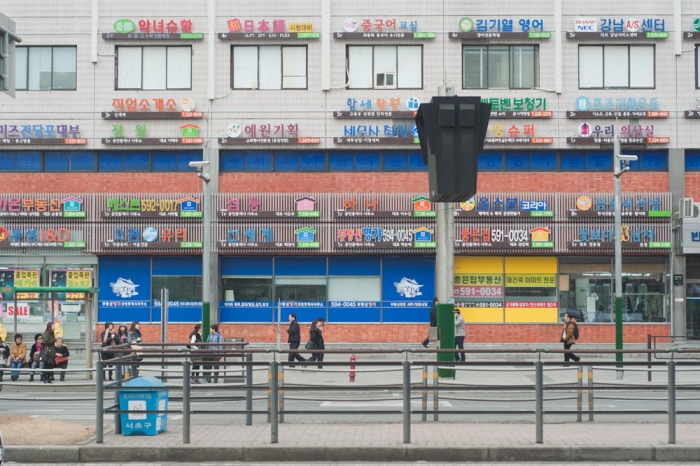




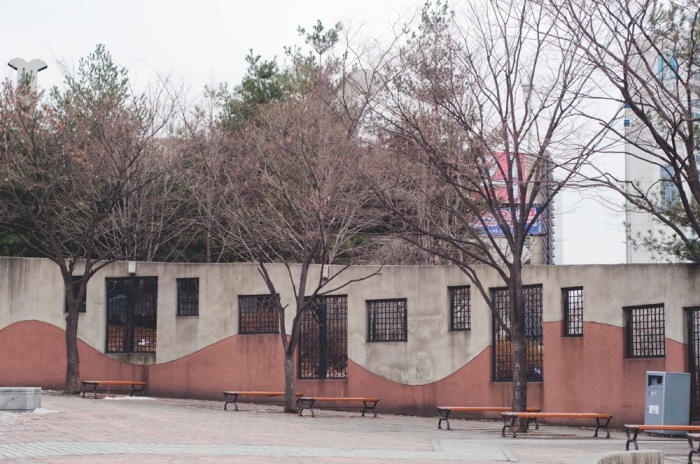





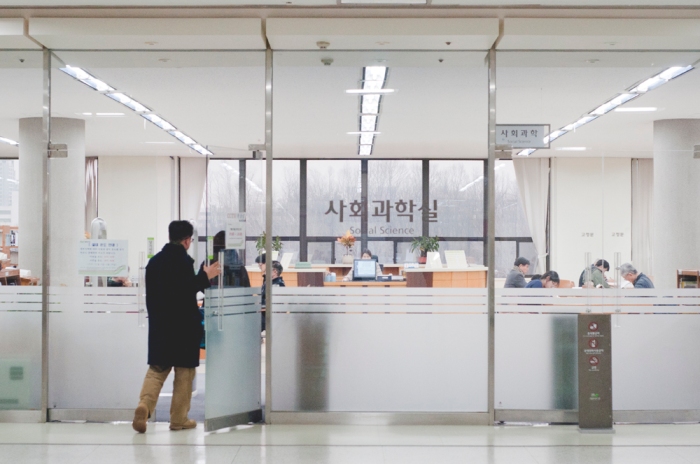










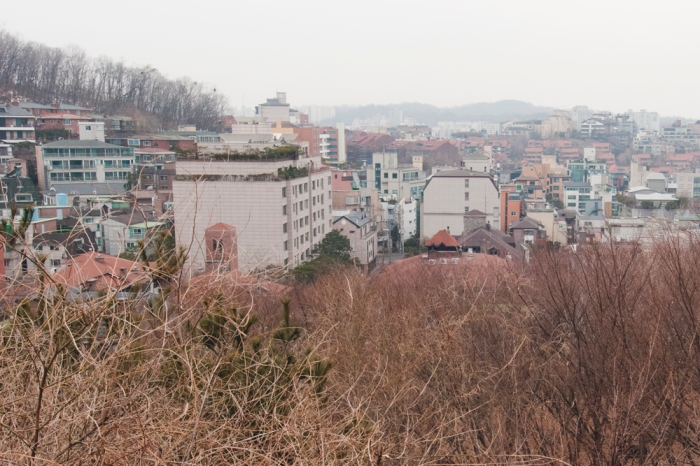






I like this staion very much and I enjoyed this post very much, too!
-Christina from Shanghai
is there any luggage storage inside the terminal?
There are lockers, some pretty big, at most if not all stations.
Pingback: SEOUL SOLO | MORE THAN A PAGE
Hi Seoulsuburban,
I have enquiry/help, If I were to go to Seoul Express Terminal from Incheon Airport by 6020 limousine bus, Which station I have to alight. is it Gangnam Bus Terminal? Is this Gangnam Bus Terminal is same as Seoul Express Terminal..
Thank you.
Hi Izah, yeah, it looks like Gangnam Bus Terminal is the same as Seoul Express Bus Terminal. I have no idea why the website says Gangnam Bus Terminal. It’s never called that.
Thank you for your clarification. It is really helpful.
Thank you on your details attractions info nearby subway lines. It help us to plan our trip.
감사합니다 &
좋은 일을 계속 (hope I write it correctly).
No problem! Hope you have a great trip!
Reblogged this on lisa bond photography and commented:
Express Bus Terminal a/k/a Gangnam Bus Terminal | Seoul
Wow, this is a very in-depth post about this place. There is so much to do here. I love to go here for the flowers.
I really enjoyed this site. Great job. Great effort